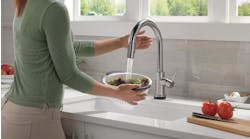Latest from Hydronics Systems
Sponsored
By Rob "Doc" Falke
Many of you have responded to recent water balance articles with this question: “What do we do when a water system lacks balancing valves and test ports?" Let’s take a look at how you can test, diagnose, and report the performance of unbalanceable hydronic systems and make recommendations to provide customers solutions.
Although unbalanceable hydronic systems are considered substandard, here are some basic inspection, test, and repair tips to help you improve these water systems.
Smaller Systems
Many unbalanceable hydronic systems are smaller and not designed or built to be balanced. Often, the budget for these jobs is low, there is no design or specification, and the installing contractor assumes it to be a self-balancing system.
Although substandard, each of these systems includes the most basic water system components. There’s a pump, piping, and some source of heat generating and transfer equipment. That’s about it.
Typically, this system type may include a standard or tankless water heater or perhaps a small boiler. While most of these smaller systems move hot water, some may also move cold water.
Heat transfer equipment may include an air handler with a coil, baseboard units, a radiator, or simple domestic water circulation systems.
What’s Missing?
Many of these smaller systems are built without essential components that allow measurement or balancing.
Test ports near the pump.
When balancing a water system, one of the first steps is to measure pump pressures and plot water flow through the pump. Without pressure testing, this test is impossible. When testing an air system, installing test ports is easy -- you drill 3/8-in. holes through sheet metal in the duct or equipment. Installing test ports in piping is much more difficult when fluid squirts out.
Balancing valves.
Once you know water flow through the pump, a balancing valve gives you the ability to regulate system flow. Balancing valves also contain test ports that allow you to accurately measure and adjust water flow through the system or to a single device.
Any recommendations you make in the customer report should always include installing balancing valves and test ports or “Pete’s Plugs.” Installing these devices in the system provides access to water flow pressures in the pipe, so you can interpret system flow.
The best approach to diagnosing an unbalanceable hydronic system is to document available system information. Inspect the system to gather the initial information.
Inspect the Water System The best approach to diagnosing an unbalanceable hydronic system is to document available system information. Inspect the system to gather the initial information.
Since plans and specifications for unbalanceable hydronic systems are rarely available, first read and record the nameplate information on the pump and heat transfer equipment. With the manufacturer and model number, you can go to the manufacturer website and download the equipment engineering information. This will provide a firm foundation for your system assessment.
Walk and inspect the system and make note of obvious installation defects. Defects often include:
- Absence of flow control valves and test ports
- Undersized piping
- Excessive fittings
- Poor equipment installation
- Wiring and control defects, and
- Evidence of leakage.
While you complete your inspection, create a list of repairs and upgrade recommendations that will improve system performance.
Start-up the System Adjust the controls to call for the desired operating mode to start the system. Assure the system responds appropriately to each control change and note any corrections needed on your report for your customer.
Any flaw or defect you find will lead you closer to the solution your customer wants.
Listen to the system start and operate. Document unusual noise, vibrations, water hammering, or air moving through the water system.
Find the problem yet?
Surprisingly, when you inspect the system, review equipment specifications, and start-up the system, the problem often reveals itself. You’ll find many of these repairs during inspection:
- Should there be air in the system, bleed the air through the bleed valve.
- If the strainer (system filter) is plugged, clean it.
- When pump speed is adjustable, note and adjust the pump speed accordingly.
- If there is a power or control issue, correct it.
Temperature Testing
Since both heat-generating and heat-transfer equipment create or release heat, temperature testing and diagnostics can be very effective on hydronic systems. The quality and accuracy of temperature measurement pipe clamps are increasing while their cost is decreasing.
Measure the temperature on the pipe surface before and after the equipment. This temperature can be interpreted as the fluid temperature in the pipe with reasonable accuracy. Subtract the two temperatures to find the temperature difference.
One word of caution; when testing and diagnosing hydronic system temperatures, understand they are affected by both fluid flow and deficient equipment performance. When diagnosing system temperatures, your evaluation must consider flow and equipment function as two separate causes of performance losses.
Compare the measured equipment temperature change to the manufacturer listed temperature change range. Typically, if the temperature change is low, this is evidence of either high fluid flow or poor equipment performance.
Should the temperature change be mid-range, this may indicate the system’s flow and performance is acceptable.
When the temperature change over equipment is high, it may be good evidence of low fluid flow.
Recommending Solutions
The best hydronic system diagnostics require test ports and balancing values to measure and calculate actual system performance. However, whenever you’re called to solve problems on an unbalanceable hydronic system, you can use the steps included in this article to improve the performance of most systems.
Even if you’re able to make a degree of improvement, always include recommendations to install test ports and balancing valves in your final report. This educates your customer and reduces future liability. The additional recommendations can and should then be addressed in the future.
Rob “Doc” Falke serves the industry as president of National Comfort Institute, Inc., an HVAC-based training company and membership organization. If you're an HVAC contractor or technician interested in a hydronic system inspection procedure, contact Doc at [email protected] or call him at 800/633-7058. Go to NCI’s website at nationalcomfortinstitute.com for free information, articles, and downloads.


